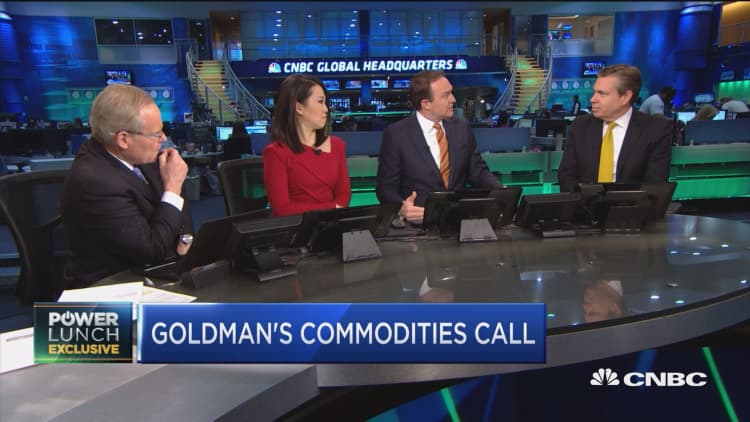
U.S. gasoline supplies are piling up, and while that might not help drivers much, it could be a negative for the price of oil.
The glut is growing as refineries head into spring maintenance season, which means even less demand for crude to make gasoline. As for the consumer, prices typically rise at this time of year but the hike could be slightly less.
Crude inventories increased by 6.5 million barrels in the week ended Jan. 27, and gasoline inventories rose by 3.9 million barrels last week and are at above-average levels, according to Energy Information Administration data. Diesel supplies were also up 1.6 million barrels.
"You might have the oddity of gasoline prices moving higher while crude oil stays in a range. That's because there's enough refinery maintenance that there's going to be substantially less demand for crude oil from Feb. 15 to April 15," said Tom Kloza, global energy analyst at Oil Price Information Service.
The fuel stockpiles are building even as the U.S. has been exporting record amounts of fuel, and refineries have cut back on output as they perform turnaround maintenance before switching to summer fuels. Exports of gasoline totaled 902,000 barrels a day last week, off recent highs but the four-week average of 922,000 barrels is double the amount exported a year ago. Diesel exports were at 880,000 barrels, off from the week earlier's 1.1 million barrels a day.
"If we come out of turnarounds and margins are terrible because product inventories build instead of draw, we could be looking at a correction in late February, March time frame, which sets the stage for basically higher lows," said Michael Cohen, head of energy commodities research at Barclays.
Cohen said he is expecting a slightly lower price for oil than he previously forecast. He shaved his first-quarter average price for Brent, the international benchmark to $55 per barrel from $57 but he retained an average $57 for the year. was just under $57 Wednesday, and U.S. West Texas Intermediate oil futures were a few dollars below that at $53.73 per barrel.
Cohen said the outlook will also depend on what OPEC decides at it's spring meeting and whether producers continue to comply.
Kloza said U.S. oil production may also become a factor for prices. He said government data showed November output at 8.9 million barrels a day, about a half million barrels more than OPEC anticipated when it reached a deal with Russia and other producers to cut production.
"U.S refiners are going to move into turnarounds and they're going to be using less crude, a million barrels a day less. At the same time, we're going to be producing 400,000 to 500,000 more a day than what was expected. ... That's going to have an impact. That's a million and a half difference on balance. It looks like [prices] should be somewhat sluggish," Kloza said.
Oil prices were higher Wednesday amid signs that OPEC producers and non-OPEC countries, like Russia were keeping their commitment to cut output to boost prices. Oil was also supported by comments from U.S. National Security Advisor Michael Flynn said the White House is putting Iran on notice. He said thewarning is a response to Iran carrying out a ballistic missile test.

"The oil price is reacting to the implementation of production cuts by OPEC And non-OPEC producers. Inventory statistics today showed products building across the board," said Andrew Lipow, president of Lipow Oil Associates. "If we're seeing not only inventories here but inventories worldwide increase there would be worldwide pressure on oil prices. It's clear it will pressure prices down but we have to see what happens with the rest of the world."
Lipow said the higher inventories could help keep a lid on gasoline price gains. He said the national average of $2.27 per gallon could go up about 15 cents over the next eight weeks, less than it might have been with less supply.
"You won't have to worry about running out of gas this summer," Lipow said. He said gasoline stockpiles are just 1.6 million barrels below the record high of last February. "Something else that jumps off the page is how much gasoline demand is down. We're down 5.7 percent from the same period last year," said John Kilduff of Again Capital. "Sometimes it says something about the economy."
Kilduff said the slower demand from drivers could mean even lower demand for crude from refineries, at a time when there is a giant long position in oil. While OPEC should be able to continue to support the market, he said there is a risk crude could fall into the $40s.
Kloza said the demand drop has been surprising, and it's unusually large. While such declines sometimes precede economic slowdowns, he said it's possible demand is lower because consumers are buying and driving more fuel efficient cars.
"We're waiting for America to drive again," he said. "I think it's new cars. I think it's an older demographic." But that still does not explain the size of the decline, he said.
Kloza said he expects unleaded gasoline to rise to $2.50 to $2.80 per gallon this spring. "We're about 47 cents above last year," said.
One reason that consumers won't get much relief at the pump is because of the fact that the gasoline glut is made up of winter fuel. "It's gasoline that has to be cleared as you go into the spring weeks. It's almost every year you have the glut. Unfortunately, it has to be cleared away and that creates tight supplies," he said.



